Ali’s Recipe of the Week: Sneaky Veg Cake (with swede!)
The swede crop this year is doing very well, and if you’re running out of ways to use up this ubiquitous winter root, try this unusual recipe idea. The friend who suggested the recipe to me gave it the thumbs up, as did her 2 children, and with the use of ‘flax eggs’ it’s possible to make it vegan / egg and dairy allergy friendly – a must in that family. You should have enough swede from any size of share to make this cake.

Ginger swede cake
PREP TIME: 15 mins
COOK TIME: 40 mins
TOTAL TIME: 55 mins
INGREDIENTS
2 large eggs or two flax eggs – see notes below
100 g dark brown sugar
120 ml maple syrup or agave syrup
150 ml sunflower oil
2 pieces stem ginger finely chopped
2 tablespoons syrup from the stem ginger jar
175 g plain flour
2 teaspoons baking powder
2 teaspoons ground ginger
200 g grated swede
To ice (optional)
100 g icing sugar
1-2 tablespoons cold water
INSTRUCTIONS
Pre-heat the oven to 180°C(fan)/200°C/gas mark 6. Grease and line with baking paper a 20cm/8inch square cake tin.
Beat together the 2 eggs (or flax eggs), 100g brown sugar, 120ml syrup, 150ml sunflower oil, the chopped stem ginger and 2 tablespoons of ginger syrup in a large mixing bowl.
In a separate bowl sift together 175g plain flour, 2 teaspoons baking powder and 2 teaspoons ground ginger. Fold the dry ingredients into the wet ingredients until combined and finally mix in 200g grated swede.
Bake in the oven for 35-40 minutes until golden brown and a skewer inserted in the centre comes out clean. Leave to cool completely in the tin before turning out.
To ice (optional)
Mix together 100g sifted icing sugar with a tablespoon of cold water. Add the remaining water gradually, mixing it in as you go so it doesn’t get too runny. If you put in too much water simply sift in a little more icing sugar.
Drizzle over the cake and leave to set.
NOTES
To make 2 flax eggs mix together 2 tablespoons of ground flax seeds (also known as linseeds) with 6 tablespoons of cold water. Leave for a few minutes until you have a thick paste and then use in place of eggs in this recipe. You can also use chia seeds.
From Sneaky Veg
Rebecca’s Recipe of the Week: Squash, Mushrooms, Blue Cheese
Hugh Fearnley-Whittingstall describes this as a ‘River Cottage classic’, and it is easy to see why. The unctuous quality of roast squash combines well with the umami flavours of the mushrooms and cheese. It tastes rich and luxurious without being heavy or cloying.
You can also use other cheese such as shavings of parmesan, or a hard goat’s cheese in place of the blue cheese.
Warm Salad of Mushrooms and Roasted Squash
Serves 3-4
Ingredients
Salad
approx. 1kg squash
12 sage leaves
4 garlic cloves, thickly sliced
100ml rapeseed oil
large knob of butter
300g mushrooms, thickly sliced
Large handful of rocket or mixed salad
150g blue cheese, crumbled
Salt and pepper
Dressing
3 tablespoons rapeseed or olive oil
1 tablespoon balsamic vinegar
¼ teaspoon salt
a few grinds of pepper
Preparation
Preheat oven to 190C.
Peel halve and deseed the squash. Cut into 2-3cm chunks and put in a roasting pan along with the sage leaves, almost all the rapeseed oil and a generous seasoning of salt and pepper. Roast for about 40 minutes, stirring once, until soft and coloured at the edges.
While the squash roasts, prepare the dressing by combing the ingredients in a small lidded jar and shaking vigorously.
When you are ready to eat, put the last drizzle of oil in a frying pan with the butter. Heat over medium heat and then add the mushrooms, along with another pinch of salt and a grind of pepper. Fry for 3-5 minutes, or until they are cooked and any liquid they have released has evaporated.
Mix together the mushrooms and squash (in the roasting tin, or frying pan, say) and toss with the dressing. Array the rocket on a serving platter and then top with the squash and mushrooms. Distribute the cheese on top and serve it forth.
Recipe adapted from Hugh Fearnley-Whittingstall, River Cottage Veg Everyday! (2011).
Rebecca’s Recipe of the Week: Carrots, Lentils, Coconut, Spinach
Very good straight off the stove, and even better the next day. The grated carrot and spinach lighten the dhal, and also add beautiful little green and golden flecks to the duller gold of the lentils. The coconut milk stays in the background, adding sweetness and rich flavour without overwhelming the balance of tastes. This is good served with rice or bread, yoghurt and a pickle.
Quick Carrot Dhal
Serves 4
Ingredients
2 cloves garlic, peeled
thumb-sized piece of ginger, peeled
1 green chile, chopped—remove the seeds if you prefer
1 red onion, peeled
vegetable or coconut oil
1 teaspoon cumin seeds
1 teaspoon coriander seeds
1 teaspoon black mustard seeds
1 teaspoon ground turmeric
1 teaspoon ground cinnamon
½ teaspoon salt
200g red lentils
400ml coconut milk
600ml water
6 medium carrots, peeled and topped and tailed
2 large handfuls of spinach, coarsely chopped, or about 8 ‘cubes’ of frozen spinach
Juice of 1 lemon
Big handful of coriander, coarsely chopped
Preparation
Finely grate the garlic and ginger. Mince the onion.
Heat a large saucepan over medium heat and then add the oil. When it is hot add the garlic, ginger, chile and onion. Turn the heat to low and cook for 10 minutes until everything is soft but not browned. Stir periodically, so that it does not stick.
Meanwhile, toast the cumin and coriander seeds in a dry skillet for a few minutes, until they release a lovely smell. Set aside to cool for a few minutes, then put them into a mortar and crush them a little—they needn’t be ground.
Add the crushed cumin and coriander to the pan along with the other spices and salt. Turn up the heat to medium and cook for a minute or two. Now add the lentils, coconut milk and water and bring to a simmer. Turn the heat to low, cover and cook for 30 minutes, or until the lentils are tender. Add more water if it seems dry, and stir every one and then so it does not stick to the bottom of the pan.
While the lentils are cooking, grate the carrots coarsely and add to the lentils after they’ve cooked for about 20 minutes.
Once the lentils are tender, add the spinach and cook for a new more minutes until the fresh spinach wilts, or the frozen spinach defrosts and amalgamates into the dhal.
Stir in the lemon juice and the coriander. Taste, add more salt if you feel it necessary, and serve.
Recipe adapted from Anna Jones, The Modern Cook’s Year (2017).
Rebecca’s Recipe of the Week: Hasselback Celeriac with Miso and Red Onion
Meera Sodha says she created this recipe largely because she liked the sound of ‘hasselback celeriac’. Name aside, this is very good. Serve the rich, miso-roasted celeriac and Turkish salad inside a flatbread, topped with a drizzle of tahini sauce and you will have yourself a sticky, messy treat. The recipe has several different components but is actually very straightforward.
Incidentally, Hasselback is the name of a restaurant in Stockholm. The better-known Hasselback potatoes were supposedly invented there in the 1950s.
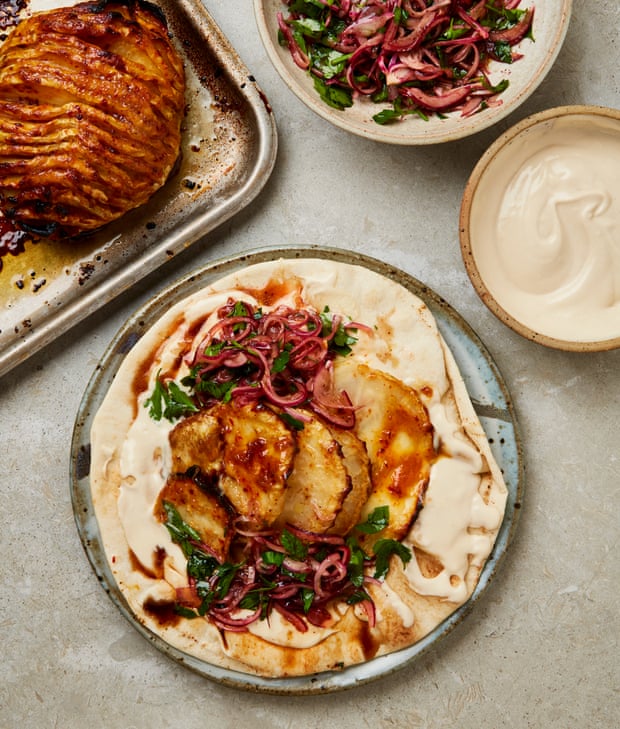
Hasselback Celeriac with Miso and Red Onion
Serves 3
Ingredients
For the celeriac
1 large or 2 small celeriacs (about 1-1.2kg total)
2 tablespoons olive oil
pinch of salt
For the miso glaze
60g white miso
½ tablespoon Turkish pepper
2½ tablespoons honey or brown rice syrup
1½ tablespoons lemon juice
For the tahini sauce
100g tahini
5 tablespoons water
1 tablespoon lemon juice
½ teaspoon salt
For the salad
1 large red onion, peeled, halved and sliced into thin half-moons
1 tablespoon pomegranate molasses
1 tablespoon lemon juice
1 teaspoon sumac
3 tablespoons olive oil
¼ teaspoon salt
1 large handful parsley, coarsely chopped
To Serve
6 flatbreads (look here for an excellent recipe)
Preparation
Heat the oven to 200C (180C fan).
Chop off the base of the celeriac, and peel off the skin using a peeler or a sharp knife. If it is large, cut it in half and lay it flat on its cut side. Using your sharp knife, cut slices at 5mm intervals that go nearly but not all the way through, so that the slices are still joined at the base, like the pages join the spine of a book. The illustration shows one way to ensure that you don’t accidentally cut all the way through: place a wooden spoon handle or chopstick on either side of the celeriac, so that when you cut, they prevent the knife from slicing all the way to the work-top.
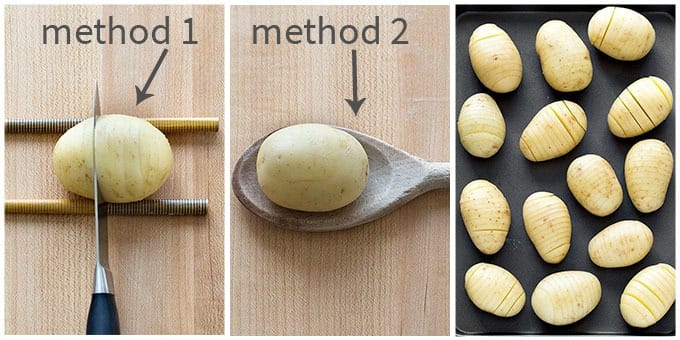
Now place the celeriacs on a baking sheet and drizzle with 2 tablespoons of oil and a pinch of salt. Place in the oven and roast for 70-90 minutes. Check partway through and drizzle with a little more oil if necessary. When they golden brown, they are ready for the glaze.
While the celeriacs roast, prepare the other components of the meal.
For the miso glaze: mix all the ingredients together in a small bowl.
For the tahini sauce: whisk all the ingredients together and put in a serving bowl.
For the salad: combine all the ingredients except the parsley in a serving bow. Mix together using your hands, and scrunch up the onions a little to soften them. Then add the parsley and set aside so the flavours can blend while the celeriac roasts.
Once the celeriac is golden and tender, brush with the miso glaze. Try to get some of the glaze between the slits. Bake for another 8-15 minutes, or until the celeriac is sticky and golden brown.
To serve, take the celeriac, salad, tahini sauce and bread to the table. Assemble your own combination of flatbread layered with celeriac and pomegranate-onion salad, topped with a generous serving of tahini sauce.
Recipe adapted from Meera Sodha, The Guardian, 13 Feb. 2021
Rob’s Recipe of the Week: A Riffable Root Bake
It’s getting to that point in winter where I’m starting to run low on root veg recipe ideas again (I need to look back at the blog for inspiration!) but this simple parsnip and potato bake caught my eye. I’m sure there’s a lot of opportunity to riff on this recipe too.
Honey-Mustard Parsnip & Potato Bake
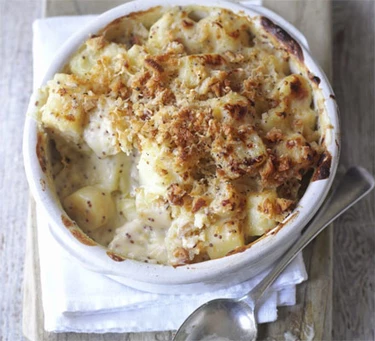
Ingredients
800g potato like Desirée, cut into 2.5cm cubes
800g parsnip , cut into 2.5cm cubes
85g butter
85g plain flour
600ml milk
2 tbsp wholegrain mustard
2 tbsp clear honey
2 tbsp white wine vinegar
85g fresh white bread , whizzed to crumbs
25g grated parmesan (or vegetarian alternative), grated
Method
Bring a large pan of salted water to the boil. Tip in the potatoes and parsnips, bring back to the boil and simmer for 5 mins. Gently drain so they don’t rough up too much, then tip into a baking dish.
(Make a bechamel) Melt the butter in a big saucepan, then stir in the flour and cook for 2 mins. Gradually stir in the milk to a smooth, lump-free sauce. Cook gently, stirring constantly, until the sauce is nicely thickened – about 5 mins. Stir in the mustard, honey, vinegar and some seasoning. Pour evenly over the potatoes. Mix the crumbs and cheese together, then scatter over the top and set aside until ready to bake. You can cover the dish and chill for up to 24 hrs before finishing.
Cook the bake at 200C/180C fan/ gas 6 for 30-40 mins until the top is crisp and golden and the sauce hot through.
From BBC Good Food
Recipe of the Week: Chocolate Brownies with a golden twist
Thanks to veg member Xandra for suggesting this recipe all the way back in September. When I needed a recipe today, and saw there’s golden beetroot in the share next week, this unused recipe sprang to mind. All sizes of share will have enough beets for this recipe with some to spare. You could also use this week’s more conventional red beetroot with dark chocolate for a luxury brownie.
White Chocolate and Golden Beetroot Brownie

INGREDIENTS
250g white chocolate
250g unsalted butter
150g plain flour
2 tsp baking powder
250g golden beetroot, cooked
250g organic granulated sugar
3 eggs
METHOD
Grease and line with parchment paper a 10in square baking tin.
Melt the butter and add the white chocolate and stir until the chocolate starts to melt, be careful not to overheat the chocolate as it will start to split. Blend the cooked beetroot to a puree and add to the butter and chocolate and stir.
If you have one, place in an electric mixer, and using the paddle attachment add the sugar and eggs and mix until pale and light in colour. Otherwise do the same with a traditional mixing bowl and wooden spoon.
Slowly add the chocolate mix in 3 batches, mix thoroughly, then add the sieved flour, baking powder.
Pour into the baking tin and bake for 25 mins at 160°c or until golden brown, you want it to still have a slight wobble.
Remove from the oven and cool on a wire rack, once cool, remove from the tin and slice into portions, sprinkle with icing sugar and serve.
Adapted from https://www.yeovalley.co.uk/recipes/recipe/white-chocolate-golden-beetroot-brownie/
Rebecca’s Recipe of the Week: To the Immortal Memory
This past Monday was Burns Night. A proper Burns Night supper should include, alongside haggis and a good deal of whisky, a convivial toast to the immortal memory of Robert Burns. This year, as we long for conviviality, and remember the shades of a great many people, it seems appropriate to offer a traditional Scottish dish, worthy of a private, 2021 version of Burns Night, or just a meditative mid-week supper.
The dish I’ve chosen is Cullen Skink, a sort of Scottish version of vichyssoise. It consists of a creamy leek and potato soup augmented with rich and salty smoked haddock. It’s best eaten with a piece of good bread. This recipe (and some bread) will satisfy four convivial or meditative diners.
Cullen Skink takes its name from the village of Cullen, in north-eastern Scotland, and the word ‘skink’, which means ‘soup’. (Skink, if you’re interested, probably comes from the Middle High German Schinke, or ham.) Neither the Oxford English Dictionary nor I have succeeded in tracing the dish back earlier than than about 1910, so it’s probably not the most ancient of Scottish recipes, but it’s very good nonetheless.
Cullen Skink
Serves 4
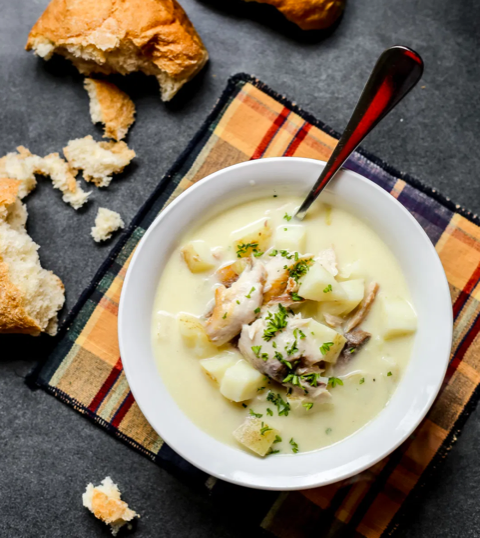
Ingredients
300g onions
500g leeks
60g butter
500g potatoes
4 bay leaves
1 lemon, juiced
Freshly-ground black pepper
400g natural (undyed) smoked haddock, cut into large chunks
150ml single cream
2l boiling water
Fresh chives, to garnish
Preparation
Peel the onions and dice them into 1cm chunks.
Top and tail the leeks. Cut the leeks into 1cm chunks and then rinse them in a colander to remove any dirt.
Heat the butter in a large, heavy-bottomed saucepan. When it is melted add the onions and leeks and cook over very low heat for at least 20 minutes, or until the vegetables look tender and soft, but not browned. Keep an eye on it so that they don’t stick or burn. It is fine to cook them for longer.
Meanwhile, prepare the potatoes. I’d favour leaving them unpeeled but if this seems wrong to you feel free to peel them. In any case, chop them into 2cm chunks and set aside.
Once the onions and leeks are soft and very translucent, add the bay leaves, lemon juice and pepper to the pan. Stir and then add the potatoes. Cook for 10 more minutes, so that the potatoes start to release their starch, which will make for a nice, thick soup.
Add the water to the pan, so that the vegetables are completely submerged. Bring to a simmer and cook for 15-25 minutes, or until the potatoes are tender. Add more water along the way if necessary to ensure that the vegetables remain under water.
Once the potatoes are tender, add the haddock and cook over low heat for another 5 minutes or so. Pour in the cream and cook over a very low heat until the soup is heated through. If you’d like it thicker, simmer it for a further 10 minutes. Taste to check the seasonings and add more salt (the fish will already have brought considerable salt to the dish), pepper or lemon if you like.
Serve, garnishing the bowls with chopped chives and a further grind of black pepper.
Recipe adapted from Tesco Magazine, Jan. 2021.
Rob’s Recipe of the Week: Getting through the ‘taters Hasselback style
The potato haul was very good this year and this seems to have resulted in a slowly growing bag of potatoes in our house. So this week I’ve been thinking about some new ways to get through them all. Today’s recipe may not be new for all of you but I’ve never tried it and I’m excited to give it a go!
Hasselback potatoes
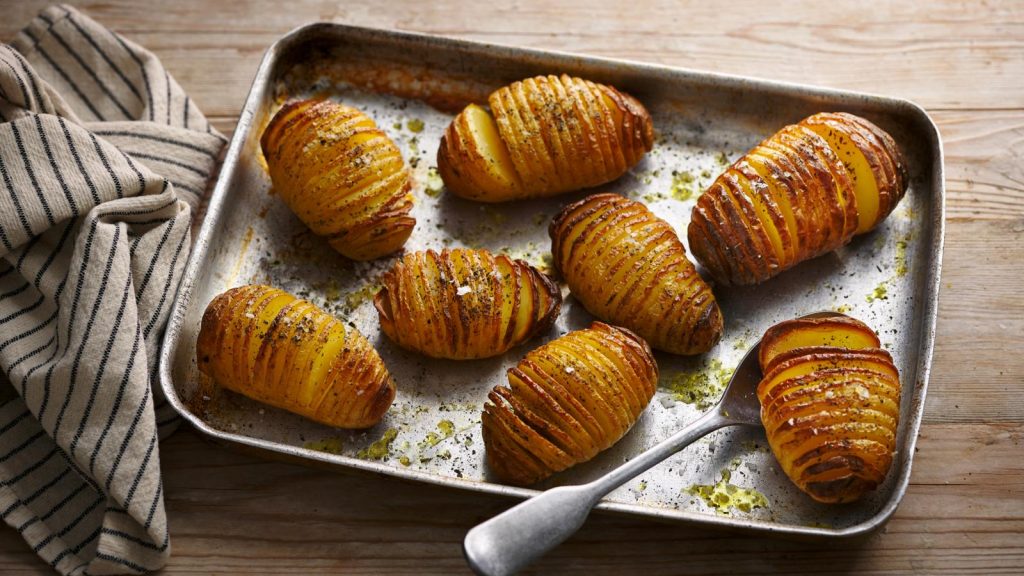
Ingredients (serves 4)
½ tsp dried thyme, rosemary or mixed herbs
½ tsp flaked sea salt
½ tsp coarsely ground black pepper
3 tbsp sunflower, vegetable or olive oil, plus extra for greasing
8 small–medium potatoes, each one approx. 75g/2¾oz, scrubbed (ideally, all-rounders or floury potatoes)
small knob of butter, approx. 15g/½oz (optional)
Method
Preheat the oven to 200C/180C Fan/Gas 6. Lightly oil a baking tray. Mix the herbs, salt and pepper in a large bowl. Pour the oil into a second bowl.
Place two wooden spoons or chopsticks on a chopping board, about 5cm/2in apart. Place the potatoes one at a time between the handles. Using a sharp knife with a thin blade, cut the potatoes very thinly and vertically almost all the way through – the knife will stop slicing when it meets the spoons. Each slice should be a little narrower than a pound coin.
As you prepare each potato, add it to the oil and turn to coat, then add to the seasoning mix and rub all over the potato, making sure a little of the seasoning mix gets in between the slices.
Place the potato on the baking tray, cut-side up. Prepare the remaining potatoes in the same way. Drizzle any remaining oil over the potatoes and bake for 40 minutes.
Take the tray out of the oven and dot each of the potatoes with a little butter, then bake for a further 10 minutes, or until golden, crisp and tender. Check for tenderness with the point of a knife or the tip of a skewer. (If you don’t want to use butter, cook the potatoes for around 50 minutes in total.) Serve immediately.
I’ll probably try slotting some cheese in between the slices, and maybe topping with bolognese or sour cream.
Adapted from BBC Food
Rebecca’s Recipe of the Week: Roast Parsnips, Lentils, Cheese
Here we have a warm, sustaining main-course salad made bright with greens and the bite of mustard. It’s a good use of that parsnip that’s still in your fridge. You can make a meal of this, along with some good bread and a glass of red wine.
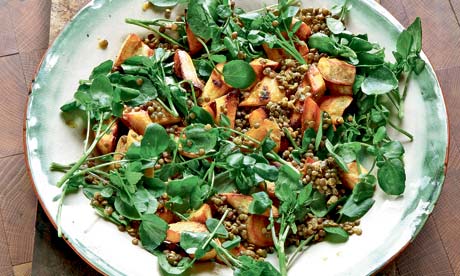
Roast Parsnip, Watercress and Lentil Salad
Serves 3
Ingredients
Salad
5 medium parsnips
2 tablespoons oil
salt and pepper
125g Puy or green lentils
2 bay leaves
1 medium onion, unpeeled
several parsley stems (optional)
several big handfuls of watercress or rocket
any hard cheese, to shave over the top
Salad dressing
1 clove garlic
½ teaspoon salt
1 teaspoon English mustard
2 teaspoons runny honey
1 tablespoon lemon juice
4 tablespoons rapeseed oil
Preparation
Preheat your oven to 190C.
Peel the parsnips and cut them into chunky batons. Toss them with the oil and a sprinkling of salt and pepper. Tip them onto a baking tray and roast for 30-40 minutes, or until they are tender and a bit golden. The time will depend on how large they are. You can poke them with a fork to see if they are soft inside. Remove from the oven and leave them to one side.
Meanwhile, prepare the lentils: cover them with boiling water and bring back to a boil. Boil for one minute, and then drain.
Return the drained lentils to the pan and add just enough water to cover them. Add the bay leaves, onion and parsley stalks (if you have any to hand). Bring to the boil, reduce to a simmer, and simmer for about 30 minutes, or until al dente. Drain and remove the bay leaves and parsley. It’s up to you either to remove the onion or to leave it in the finished salad.
While the lentils cook and the parsnips roast prepare the salad dressing. Mash the garlic with the salt in a mortar and pestle to make a smooth paste. Whisk in the other ingredients.
When the parsnips and lentils are finished, toss them, still warm, with the dressing and add the watercress or rocket. Pile onto a serving platter and shave some hard cheese over the top before serving.
Recipe adapted from Hugh Fearnley-Whittingstall, River Cottage Veg Every Day! (2011) – online at rivercottage.net
Rob’s Recipe of the Week: Celeriac Soup
I wasn’t sure Celeriac soup was a good choice, but we’ve had a few Celeriacs recently and I fancied a change. It was a pleasant surprise, then, that this turned out to be super tasty in an intensely savoury way. Even better was that we risked eating it after forgetting to put it away overnight and so far we have survived!
Cream of celeriac soup
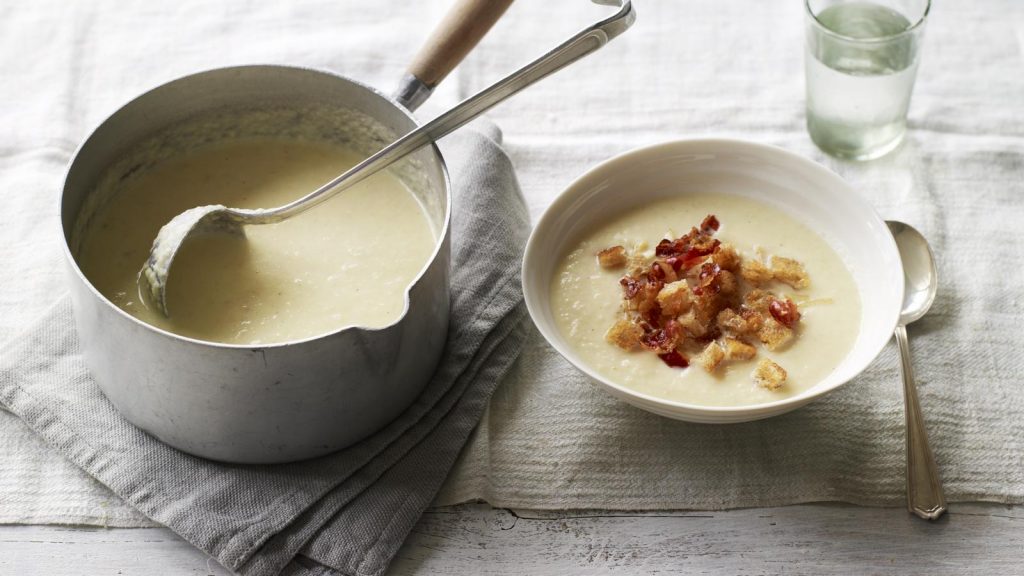
Ingredients
For the soup
75g/3oz butter
1 onion, finely chopped
50g/2oz streaky bacon, cut into small pieces (optional)
2 garlic cloves, finely chopped
1 leek, white only, finely chopped
1 stick celery, finely chopped
2 thyme sprigs, leaves picked
700g/1lb 8oz celeriac, peeled and cut into small cubes
1 litre/1¾ pint vegetable stock
200ml/7floz double cream
salt and white pepper
Method
For the soup, heat a large frying pan or saucepan until medium hot, add 25g/1oz of the butter, the onion and bacon and fry for a couple of minutes to just soften. Add the garlic, leek, celery and thyme sprigs and fry for another minute; then add the chopped celeriac. Pour in the stock and bring to the boil, then reduce the heat to a simmer and cook for 10-15 minutes, or until the celeriac is just tender.
Blend the soup to a fine purée using a stick blender or a blender. Return to the heat in a pan. Add the cream and whisk in the remaining 50g/2oz of butter.
Season with salt and white pepper. Serve the hot soup in bowls.
There is an optional garnish which can be found at the link to the recipe.
From BBC Food.